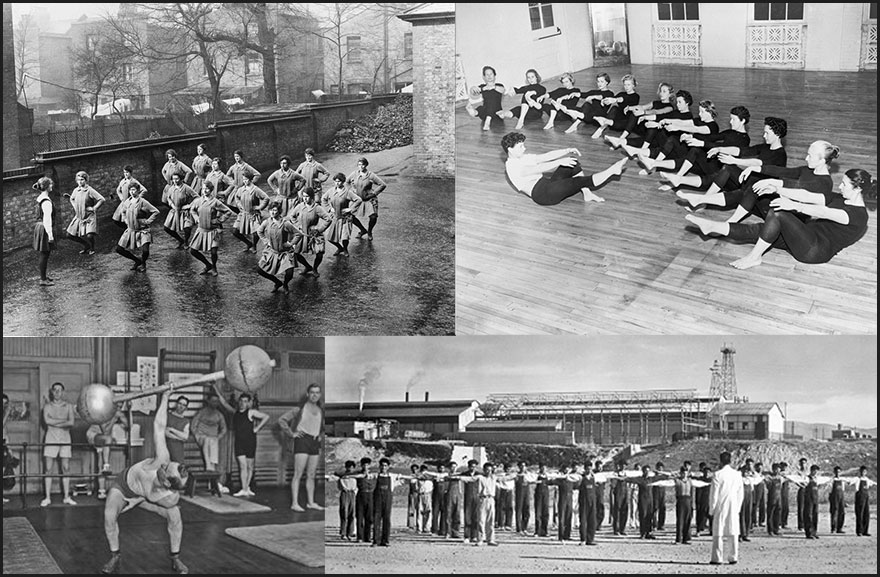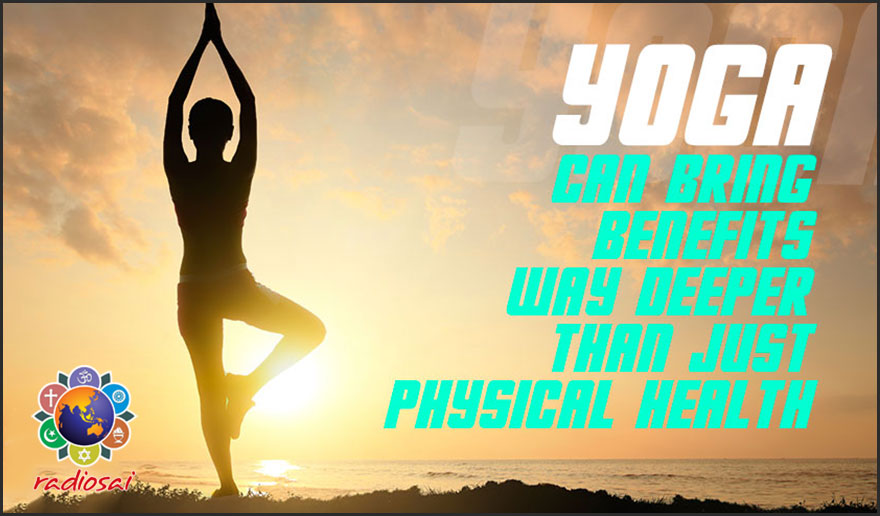|
|
| 'Like' us on Facebook | Follow us: |
Posted on: June 20, 2017
 |
On December 11, 2014 the United Nations General Assembly declared 21 June as the International Yoga Day. And thus we celebrate the third Yoga Day this year. Among the many contributions made by the ancient Indian Civilisation to the world, Yoga stands out as one that has earned wide acclaim. But is Yoga merely a form of physical exercise or is there more to it? In this article we wish to address the above question. In fact, it is an answer to a question posed to us. Radio Sai Answering Booth is a programme that is aired every Thursday as part of our Thursday Live broadcasts on Asia Stream. On this show, listeners are invited to post questions regarding various aspects of Swami's message and its practical applications in everyday life. On the show aired on 26 Jan 2017, one of our listeners, Ms Vaishali Dinkar from Pune posed the question: What is the difference between Yoga and physical exercise? In this article we present the answer to the same. This being the International Yoga Day, why not try to understand how Yoga is different from other forms of exercise, and how should we practice it to draw maximum benefit from it. |
Sai Ram. I presume you wish to know Swami’s explanation and of course the general differentiation from the spiritual point of view between Yoga and physical exercise; because, anything that is traditionally a part of Indian heritage cannot be spoken of without making references to the spiritual perspective. Indian cultural heritage and spirituality are inseparable. I should probably give you an alert that in my answer I will be speaking more about Yoga than regular exercise, but will try and contrast the two as and when possible in the course of the answer.
WHAT IS YOGA?
First and foremost, when we say Yoga, we are truly referring to Yogasanas. And Yogasanas form just one of the eight aspects of Patanjali’s Ashtanga Yoga. The eight angas or parts being Yama, Niyama, Asana, Pranayama, Pratyahara, Dharana, Dhyana and Samadhi. And Ashtanga Yoga is just one of the many types of Yogas. So what is Yoga?
 |
The word Yoga comes from the word ‘Yuj’ which means to yoke, or to connect to. So in spirituality Yoga means a method of connecting to Divinity. In other words it is a pathway to God, or a pathway to our inner Divinity or self-realisation, as we wish to call it. That is why in scriptures we have references to Bhakti Yoga - the path of devotion, Jnana yoga - the path of wisdom, or many such yogas like karma yoga, raja yoga, sankhya yoga and so on. So when we say Yoga, referring to the popular yoga we see in the world today, it is this - of the many ways to attain God, Ashtanga Yoga given by Patanjali is one, of the 8 limbs of Patanjali's yoga, Asana is just one. So even if we consider Pranayama too, at best what we refer to as Yoga is ¼th of Patanjali's Yoga. In other words, Yogasanas and Pranayama were included as a necessary means for the pathway to God. The goal is spiritual, and this technique to keep the body healthy was just a means.
Was it to keep the body healthy or is there more to it? We will come to that in a bit.
HISTORY OF PHYSICAL EXERCISE
But to be able to compare Yoga and exercise, we need to see why physical exercises were created in the first place. We will have to look a little into the history of physical exercise itself. For many many centuries civilisations did not have the concept of physical exercise at all, because most of the activities people were doing in everyday life was enough for the fitness of the body, be it working in the farm, chopping wood, cooking, tending to cattle etc. There was no need for exercise and hence there was no concept of exercise. If at all anyone had physical training, it was the men in the army. They would have fitness camps to improve their endurance, their ability to run, walk long distances, swim, climb, training in wrestling, throwing spears and weights and so on. All these were activities necessary for improving physical strength and endurance, and certain specific physical skills. Later, these were developed into sports by the Greek. That’s why initially sports competitions were nothing but physical activities they would use in warfare like hand combat, sword fighting, running, chariot and horse racing and so on. Then the Romans started the concept of Gymnasiums, and the idea behind that was to celebrate the beauty of the human body. They made it fashionable, and a part of their culture to have a fit, proportional and good looking physique. They promoted it through public gymnasiums and even through their art, by eulogising physical beauty, as we can see even today in Roman architecture and sculptures. But with time, this idea of physical fitness for all was propagated, but still, war preparedness being the primary motive. When they found that their countries could be attacked anytime from any side, they wanted that the men in the country should have a general level of fitness and endurance, so that they will be in a state of readiness to join the army as and when there was a need.
And around this time, when Christianity started spreading, that is from the 5th to the 15th century, this idea of physical beauty and giving importance to the human body was challenged. The idea that this body is a carrier of sin and it should be abhorred and ignored, came into vogue. Still fitness for military purposes continued, but the exercises were still designed to cater to the needs of warfare and even sports were designed around skills required for the military needs. The public gymnasiums and regular exercises were slowly done away with. Then came the industrial revolution in the mid-18th century and with it came automations. So after centuries of manual labour, slowly we were entering the phase of sedentary life styles. Of course it happened very slowly, but it was in this period educators began speaking about introducing physical fitness training in schools. Sports, gymnastics and such activities began becoming popular. So in this period, exercise was meant to replace manual labour which was on the decline. And most of what we consider exercise today like jogging, going to a gym for workouts and so on are trends that caught up in the 20th century. And after that we have witnessed what happened, it happens with everything else in the 20th century, and it so happened with this concept of physical exercise too. Fitness became a huge industry, and commercialisation in a massive scale followed. We were given standards of health like 6-packs, v-shaped body, size zero, so on and so forth, all of which have little to do with good health, and we were sent on a race to fit into these descriptions laid out by the fitness industry, which actually had become the fashion industry.
 |
The reason why I went into the history of exercising is, from it we can see what was meant to be the purpose of this form of physical exercise. Though the purpose the individual has in mind does matter, when a system has been created with a certain purpose, the inbuilt nature of the system will be accordingly influenced too. So in that sense, modern exercises were created to achieve battle-fitness, an attractive appearance and health in the sense of countering a sedentary lifestyle. Of course, in the process the idea that exercising does influence the state of the mind was also established, and doctors would ask us to do exercises for that purpose too. For example, now we have clearly established that endorphins are secreted when we do exercise, and endorphins help us fight stress, be in a generally good state of mind and so on. But predominantly, physical exercises, as the name suggests, was meant for the physical and so they were developed with that purpose in mind.
Now so far, I have only been giving the history from the point of view of the west, and more so the popular culture. But the case was quite different in the east or the orient, and also within some ancient civilisations in the west. For instance, in the east we had practices of martial arts, through which they always taught a larger context than just physical fitness or self-defence. But here we will of course stick to Yoga, for that is what the question is about.
THE PURPOSE WITH WHICH YOGA WAS CONCEIVED
Now talking about Yoga or Yogasanas, to be more precise, the primary purpose was to help a person progress spiritually. So when a system of physical fitness is designed with the idea that it will help one progress spiritually, the approach of that system will be completely different, and the way you assess yourself to see if you are making progress while following that system, will also differ accordingly. So at the very outset, if you consider yourself a spiritual aspirant, it goes without saying that Yoga is the better option for you. So if I am not keen on spirituality? Well, whether a person claims to be on the spiritual path or not, we all are indeed on the spiritual path. Some of us are probably like kindergarten children, who go to school but have no idea that they are going to a school and will be doing that for the rest of their childhood. But a school going kid in the higher classes will have an idea of what the process is all about. Similarly, whether we acknowledge it or not, we all are on the spiritual path.
 |
So that should correct one other of our misconceptions about Yoga too. We tend to think that Yoga is for yogis, not for regular worldly people like us or bhogis. Swami would say, to think that yoga is only for the recluses and renunciants in the forest this is a big mistake. Why do we tend to think like this? One of the reasons may be because of how we see exercise itself (as explained through its history). Many of us are likely to think, 'these yogis had to sit and do meditation the whole day, so they must’ve devised some exercises to keep themselves fit'. Appears like sound logic, but since Yoga was never about just the body, this argument is false. Another reason I can think of, why yoga was not just for yogis is, in the Ashtanga Yoga the first step is called Yama or moral conduct in society. And Swami has explained that Yama has 5 sub-principles - Satya, Ahimsa, Aparigraha, Asteya and Brahmacharya. Satya, Ahimsa - Truth and non-violence; Aparigraha, Asteya - non stealing and not desiring for gifts; and Brahmacharya or celibacy. The first four, you will agree, are clearly meant for a person living in society isn't it? For regular people like us. May be the principle of celibacy could confuse us, we may think it is only for sadhus and sanyasis. But in one of Swami’s discourses He beautifully explains that there are different types in celibacy too. For example, a married man, when in the presence of women other than his wife, should become a celibate. A married woman should become a celibate when in the presence of men other than her husband. So clearly, these five principles that for the first limb of Ashtanga Yoga, that is Yama are not for yogis in the forest but for all of us too. So one can say that the whole concept of Ashtanga Yoga was not created just for Yogis. But, its purpose was not merely for beauty, strength or even health for that matter.
THE HUMAN BEING – VEDANTIC APPROACH
To understand the difference between regular exercise, which as I said is a modern concept, and Yoga, we will have to see how different is the concept of the human being itself, when it comes to these two approaches. In the modern approach we consider ourselves as a body-mind complex at best. But what is the vedantic perspective of the human being? It is this - at the core we are Divine. And this Divine core is encased in five sheaths or five Koshas as it is called in Sanskrit. The most gross is called Annamaya Kosha or the food sheath, below that is the Pranamaya Kosha or the sheath of life energy, then there is Manomaya Kosha or the sheath of the mind, Vijnanamaya Kosha or that of the intellect and the fifth and final being Anandamaya Kosha or the sheath of bliss. So this is the human being according to ancient Bharateeya culture. What we call the Annamaya Kosha alone is the gross physical body. So physical exercise is confined to only this one kosha or the physical body made of food and water alone. At best, it makes references to the mind sheath.
So the approach of Ashtanga Yoga is this - when an equilibrium is maintained in each of these koshas, one will be able to go within up to the Anandamaya Kosha and experience limitless bliss, and with further effort, one can transcend even that state of bliss and reach the inner Divinity. And the eight-step yoga is meant to reach equilibrium in each of these sheaths. So we can say, yoga is not about exertion or spending excess energy through physical activity. But a method by which we can reach a certain inner balance.
 |
When we do physical exercises we see if we are sweating enough, are we getting strained enough, are we feeling pain in the right places and so on. But when we do yoga, after a session of yoga we must feel refreshed and rejuvenated. The mind should feel calm the whole day. With regular practice of yoga, our anger and stress must come down. We must not feel stiffness in our muscles, rather we must feel suppleness. That’s why a yoga instructor will always say, 'do as much as you can. Don’t push yourself too hard, remain within your abilities, and slowly you will be able to do more and better'. That’s because the goal of yoga is to go closer towards that bliss within, so calmness, rejuvenation and happiness is the true indication of progress when it comes to yoga.
PRANAYAMA AND HEALTH
One more attribute in which there is a clear difference when it comes to yoga is the importance given to breathing. As I mentioned, Yoga is not meant to deal only with the Annamaya Kosha. So which is the next sheath? It is Pranamaya Kosha. Again there are five pranas that form this sheath and primary among them is breath. Swami would say, even if you run a mile, your breathing should not become uneven and this can be achieved through Yoga. And how do they incorporate this? One primary means is Pranayama. And it is said, that most of the health issues in the body can be taken care of just through the practice of Pranayama. There may be five Pranas - one for digestion, one handling the energy and nerve system, one for excretion and one for speech and so on, but all of these can be effectively maintained in equilibrium through simple Pranayamas that involve regulation of breath. For instance, Swami would explain, the most common type of Pranayama, the Anulom-Vilom, is where we breathe in through the left nostril, hold our breath and exhale through the right, and vice-versa. Swami would say that the ida and pingala nadis, which actually are the important parts of the Vyana Prana system pass through the left and right nostrils respectively. So when we do this Pranayama these nadis are activated too. The other common Pranayama is Kapalabhati, this helps the Samana Prana (the digestive energies). So this entire Pranamaya Kosha is effectively taken care of by doing Pranayama. And most of the Asanas too are meant to activate nadis and chakras of the Pranamaya kosha.
 |
Apart from this standalone breathing exercise, even while performing asanas they suggest that a particular breathing pattern is to be followed. Of course the modern variants of Yoga differ in this. For example, I believe, the famous Iyengar Yoga does not insist that there should be a strict breathing pattern to go with the asanas. But traditional Patanjali Yoga had Pranayama to an extent, integrated into the postures itself. So just these two aspects of Ashtanga Yoga - Asana and Pranayama can take care of this gross body, and also the energy system within, and when these two are in equilibrium, to a great extent, the mind will be calm too.
YOGA IS INCOMPLETE WITHOUT DISCIPLINE
But for complete health, physical, mental and psychological, at least the first four steps of Patanjali’s yoga have to be practiced. That is Yama, Niyama, Asana and Pranayama. Because Yama and Niyama are means of self-discipline. Yama as I explained is discipline in our interactions with society and Niyama is self-discipline. Be it cleanliness, ceiling on desires, discipline in food and habits, all of these come under Niyama. And as Swami would say, Na Shreyo Niyamam Vina - without self-restraint and self-discipline, there can be no wellness. So to have true health as described by WHO (World Health Organisation), that is, a state of complete physical, mental and social well-being and not merely the absence of disease or infirmity, we must follow as best as we can Yama, Niyama, Asana and Pranayama. But if we wish to consciously proceed towards discovering our Divinity, then the next three steps are mandatory. That is Pratyahara or slow withdrawal of senses from objects that attract them; Dharana or one-pointed concentration; and Dhyana or meditation. And these will eventually lead to Samadhi. Samadhi does not mean death or end of life. It is complete absorption in the self, a state of absolute, undisturbed peace - the state of union with Divinity. It is a state of supreme stillness and serenity. It is said rightly, the first four limbs of the Ashtanga Yoga are Bahiranga or external aspects, the last four are Antaranga or internal aspects.
 |
I will conclude with just one point. I had mentioned that the purpose behind the creation of these systems is important. But after all this, I can still use yoga only to have an attractive body. Yes Yoga will help even if one does it purely for the purpose of physical fitness or attractiveness, but then it would be like, as Swami would say, using a kalpavriksham (wish-fulfilling tree) only to obtain coffee powder! A Kalpavriksham will indeed give you coffee powder if you ask for it, but that is not the limitation of the tree, but the limitation of our sense of purpose. Similarly, some people might be following regular physical exercises, but with a clear perspective that it is meant to maintain health and that they can concentrate on higher goals. I am sure that will have its benefits for sure. But as Swami would say, this system of yoga is so comprehensive, the weak can do it, the sick can adopt it, even the old and infirm can benefit from it. This system has been created by sages who have understood the human body comprehensively. Swami says in a discourse, that we have forgotten this science completely; some have exported it to the west, benefitted from it and have come and told us that it is so beneficial, and then we have started using it. It is indeed a pity that we neglect the treasure that we all are heirs to.
So definitely, yoga is a far more comprehensive regime for fitness as well as for general wellness.
- Prem Anosh
Radio Sai Team
| comments powered by Disqus |







